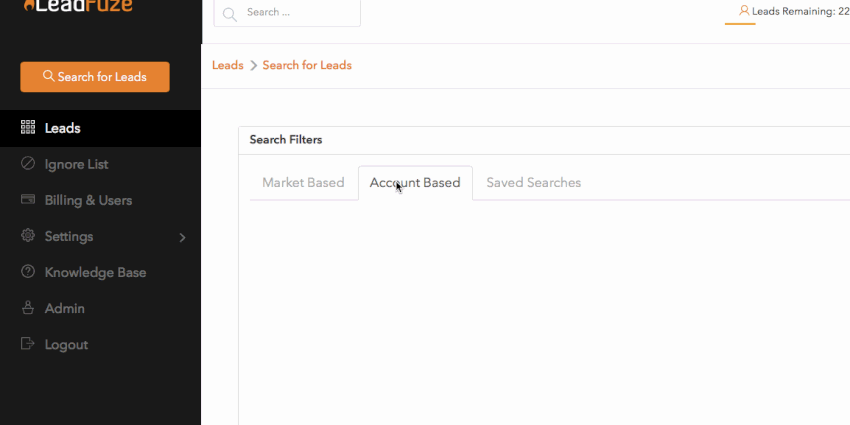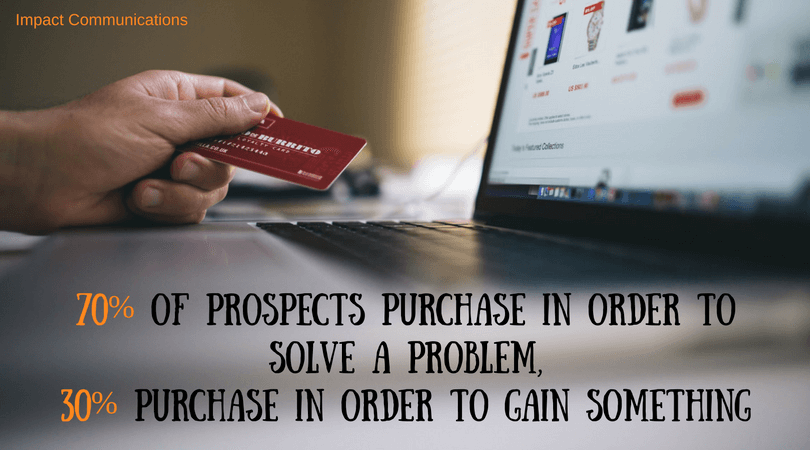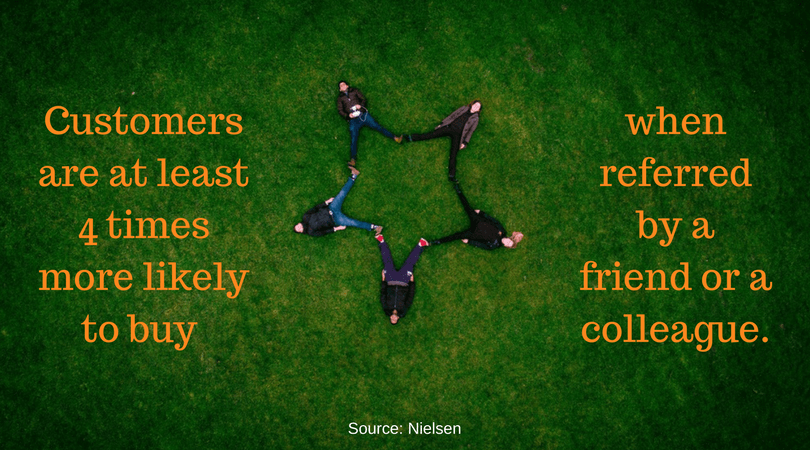What is a Sales Presentation?
A sales presentation is a talk or event where you meet with prospects or clients to give information about your products and services. The aim of making a sales presentation is to educate prospects on the unique qualities of your products and convince them to buy.
Sales presentations can be done at trade shows, seminars, conferences, and other networking gatherings as well as in person on site visits by prospective clients.
Why Are Sales Presentations Important?
When you give effective sales presentations, the biggest benefit is an increase in your sales. That’s the overarching goal. But there are other reasons why it pays to work on your sales presentation skills.
The best sales presentations:
- enhance your credibility,
- build relationships,
- answer pertinent questions your prospect has.
The key to successful selling is finding out what each customer’s needs are, what their pain points are, and how you can solve those issues and make it easier for people to buy. A good sales presentation can deliver all of this.
Before you say, ‘I am good, my sales presentation skills are on point’, hear this:
Even if we’ve been “in the game” for a long time, selling the same products — our presentations can get stale after a while. Like loaf-of-bread-left-on-the-counter-2-weeks kind of stale… blue science project mold included…
Sure, you may be so comfortable with your go-to presentation that you don’t feel much incentive to change it, but that’s a sign in itself that it’s time for a revamp.
The moment you get too comfortable with anything in the sales world, something is amiss.
Before we get to the sales presentation ideas we have for you, let’s look at the different types of sales presentations you can make.
7 Types of Sales Presentations
There are many types of sales presentations. Knowing which one to use for each sales event and prospect is the key to effective sales pitches.
Let’s look at each one and discuss when you might use them:
1 Informative sales presentation
Self-explanatory, the main goal of the informative sales presentation is to inform. It is perfect for prospects who aren’t yet ready to buy and who may still need nurturing.
Your goal with this sales presentation is to educate and fill any information gaps they may have about the problem they have and what they should be looking at as a solution.
You may aim to push your prospects closer to a purchase decision, but it’s important not to be too aggressive. Your prospects at this stage aren’t ready to buy. They are very much in the awareness stage of their buyer’s journey.
2 Explanatory sales presentation
This sales presentation explains how a product or service functions. It also provides information on why it is better than other options available in the marketplace.
Again this type of sales presentation does not push for a sale as these prospects aren’t ready to buy yet. Selling them on your solution too soon may push them back into cold lead mode.
3 Demonstration sales presentation
With this sales presentation, you are demonstrating how your product works, explaining its unique features and where the benefit is for the customer.
This sales presentation shows prospects what it is like to use the product. It is crucial for complex, high-value items whose function prospects want to be sure of before making the buying decision.
4 Value-added sales presentations
A value-added sales presentation looks to boost the invoice value with an upsell. It’s an attempt to convince the prospect to buy an additional item on top of what they have already committed to buying.
To be successful with this sales presentation, the additional item you are pitching has to truly add value to the primary purchase. It must help them get the most out of the product they have already bought and not just be an attempt to get the customer to spend more money.
5 Product launch
A product launch sales presentation is a planned introduction of a new product, often including an overview followed by demonstrations showcasing key features. It may also include a Q&A with the company’s management team to talk about their motivations for developing and launching this product.
6 Consultative sales presentation
A sales consultative presentation is one that provides customers with information so they can make an informed decision on what type of products or services will best meet their needs. It ditches the sales approach for an advisory one, giving prospects a choice of several solutions.
7 Demo & sell sales presentation
A demo-and-sell presentation is one that provides customers with an opportunity to see the benefits of a particular type of service or product by actually experiencing it firsthand.
You may first demonstrate how the product works and then, with the prospect having seen the product in action and more informed, then launch into full sales mode to close the sale.
5 Sales Presentation Ideas for the Modern Age
Sales presentations used to be mainly in-person but these days an increasing proportion of them take place online. Of course, not all products are a fit for online sales presentations.
Whether a sales presentation is online or in-person, the goals do not change. And the pressure to deliver those goals does not relent.
But what is it that really makes a successful sales presentation?
You might have seen a lot of articles out there on top PowerPoint templates for sales presentations, on how to dress properly, body language, and all that trivial stuff. Most of those facts are just secondary, compared to other priorities for your presentation.
Successful sales presentations are less about beautiful PowerPoint slides and more about how your product makes the prospect’s life better.
You could well deliver it anywhere using rudimentary equipment, but if it is truly about educating the customer on the problem and the solutions available, the sales presentation will be a smashing success.
With that said, here are some sales presentations ideas to mull over before the next time you stand in front of prospects to pitch your product:
1 Research and preparation are your strongest weapons
It is disrespectful to your prospects to get into a sales presentation without adequate preparation. For the best sales presentations, the hard graft happens in the preparation.
Thorough research about your target customers and intense preparation for your pitch and the overall approach you are going with is the key to effective sales presentations.
It is absolutely vital to understand the prospect’s needs before selling them on your solution. They are not stupid and can tell a fraud who is only after the sale by how prepared for the sales presentation they are.
- Study your prospects
- Eavesdrop on their social media discussions,
- Read articles they have published
- Research other companies they do business with
Just about any information, you can get on your prospects will help you get a better understanding of their needs. If the target is a business, find out who the decision-makers and the actual users of your product are and research them both.
Furthermore, look for information about the current state of the company’s finances. This will give you a sense of whether there is only a price objection.
Take a look at your competitors and predict how they might approach your prospects and what their weaknesses and strengths are compared to your business.
Once you have gathered all the necessary information, organize it into an ordered outline of your sales presentation. The more extensive your homework is, the better your presentation will be.
Are you struggling to generate leads to pitch with your sales presentations?
LeadFuze is a lead research tool that helps you find out everything there is to know about your prospects. We have the information on their company, website, social media profiles and much more. You can also use our tools for email outreach and marketing automation so it’s easier than ever before to get in touch with them.
With LeadFuze, you can finally stop guessing what kind of person they are or how best to reach them. Our data will help you create personalized messages that resonate with each individual prospect which means better conversion rates and higher ROI for your business. It’s time to take control of your sales process by using the most powerful lead research tool available today!
P
2 Put the prospect’s needs front and center
Picture this sales presentation like a first date. Is there anything that’s more of a turnoff than listening to your date ramble on and on about their accomplishments? Their background and the 1000 things they’ve done since graduation?
Don’t be that bad first date. You will make a great sales presentation if you make it all about the prospect. A good rule of thumb is to spend 80% of the time speaking to prospects about how you will solve a problem they are experiencing.
You are essentially courting your clients, so be that gracious date that asks questions and focuses on the person on the other side of the table. Twenty percent you, 80% them. When in doubt, just remember you are there to solve a problem.
If you have done your research properly, you will have enough information to understand the exact needs of your prospects. Use this as the main content of your presentation. Show the prospect that you are here to help them solve the problem first, for which the sale will be a reward.

This is according to a report by Impact Communications. To understand which applies to your customer, sales and marketing need to collaborate intensively to generate an effective presentation.
It is estimated that prospects complete around 57% of the buyer’s journey before they even reach the sales department. Thus, it is imperative for sales and marketing to coordinate on the content of sales presentations so they are truly about addressing the prospect’s needs.
Once you have a clear picture of the exact profile of your customer, their needs or problems and how you can help solve them, create content that makes them feel heard and cared for.
Instead of boring your prospects to death with general statistics, engage them on a personal level with interesting stories and anecdotes that directly relate to their pain posts.
Numbers usually get easily forgotten, while stories will leave a mark on the customer’s memory.
3 Work on your call to action
This is usually the most important part of your sales presentation. A call to action is the final step that nudges the prospect to make the purchase.
There are many ways you can deliver your CTA, many of which depend on the structure of your presentation. Whatever form it takes, in each and every case the purpose is to drive your customer toward purchase.
Do not end your presentation with a simple thank you.
Challenge your prospects, ask a question, invite them to do something, use an applicable quote, or even wrap up with a story.
To be effective, your call to action should cover the following aspects:
- Short and to the point: Do not bore your prospects to death. A call to action should be efficient and clear. If it is too abstract, you will miss your chance.
- Must require action: Do not mention just a famous quote that does not require any action from the people you are selling. Challenge them to choose your product/service as the right one by leaving the ball on their court.
- Summarize your offer: Your call to action should summarize the most important arguments of your presentation. A great way is to close your presentation with the final part of a story that you introduced at the beginning, which shows how all the points you presented dovetail to the offer.
This next one is less of a sales presentation idea than it is a tip, but a still useful one all the same.
4 Master Your Body Language
There are many factors you can’t control during your presentation…the obnoxiously contagious-sounding cough of the guy closest to you, the heavy breathing of the executive to your right…fortunately, one of the most effective factors is something that you can control—body language.
We have mentioned that working on your confidence is one way to improve your sales presentations. One other thing to work on is your body language. This one area can harm your sales presentation no matter how prepared you were.
Our body language says more than our vocal cords each and every day.
Our body language says more than our vocal cords each and every day
How to improve your body language
Jennifer Burnham over at Salesforce has several great tips for mastering your body language during sales presentations.
Here are her top six tips for improving your body language
- Lean forward
It’s not hard to gauge interest in a conversation. Think about a great date or a great conversation with a friend you’ve had recently. You were engaged in an animated conversation and probably nodded and leaned forward excitedly, right?
It comes naturally when you are with those you are comfortable with, but you will likely have to be a bit more conscious of it during your presentations. If you’re slumped or not looking engaged, your audience will notice it.
- Keep your arms open
Did you know that crossing your arms not only makes you look unapproachable but also makes you retain less information?
- Never point
Pointing is often viewed as aggressive and rude. If you need to gesture toward something, use a full sweep of the arm or basically anything softer than the finger point.
- Smile naturally
You aren’t a robot; the people watching your presentation want to see an actual person with actual emotions. There is, of course, a difference between a forced smile and a natural one, but try your best to smile and act naturally throughout your presentation.
- Make eye contact
One of the easiest ways to keep any audience listening to you and engaging with you is by maintaining eye contact. It gives the appearance that you are speaking directly to them; this naturally awakens curiosity and attention span.
- Notice What Your Feet are Doing
This lesser-known body language secret could be giving you away; your feet may be showing your true feelings. Studies have found that our feet naturally point to those we prefer and away from those we don’t.
When you consider the undeniable feeling we get to run away when we aren’t feeling connected, it makes sense. By comparison, if we are engaged in a conversation, we lean toward the person and naturally face them. Additionally, feet placed close together is a sign of timidness, while wide stance feet show more confidence.
5 Utilize case studies
Remember those seemingly endless days trapped in school? Listening to your teacher drone on and on…?
Chances are, you probably perked up a bit when there was at least some visual aspect or how-this-relates-to-you example. If your sales presentation consists of you talking and talking…and talking, you will lose the client’s interest.
Case studies are a worthwhile tool not only for creating visual stimulation. They’re also good for showing real examples of how your product is used and why it was a success.
They also serve as a way to cut through the confusion. No longer is it a list of 20 things you can do for them, but an actual outlined example of what you have done for others and why it worked.
It’s another form of social selling, really. We honor customer reviews above the words of a company, and when we utilize case studies, we are providing social proof that we are as good as our word.
A great post by Steve Woodruff sums up the process of using case studies in sales presentations.
His 5 main points:
- Make sure your story is tailored to your audience.
What good is your case study if it’s not relevant? No good at all, and worse yet, it can only contribute to the customer’s confusion. Especially if it isn’t focused on a relevant topic.
- Focus on the client’s main need.
There’re likely many problems you can help solve. But your goal is to focus on just one. Cut through the clutter and use a case study that speaks exactly to the problem at hand.
- Use the case study to show specifically how you can ease their “pain points.”
Every company has “pain points” or specific areas of difficulty. Reinforce how you will make life easy with your customer success stories.
- Focus on results.
The journey is great and all, but when it comes to winning clients, it’s all about the results. Make sure you focus on these.
- Include a customer testimonial or quote.
Social selling is where it’s at. When possible, utilize the voice of your clients.
Allow yourself plenty of time before your next sales presentation to utilize these changes. Learning how to make a good sales presentation could take some time. Once you do, you’ll likely feel much more confident in your presentation style.
And your client retention rates will reflect this.
6 Ask for feedback and referrals
One thing is clear: your sales presentations won’t be perfect from day 1. It is a learning process. Your best sales presentation can be many years in the making.
The best way to get better at anything is to collect as much feedback as you can. With each sales presentation, ask your prospects:
- What they liked about it,
- What they didn’t like,
- Whether the presentation felt too long or too short
- If they have any questions for you.
Of course, some of these questions may not be appropriate to ask after every sales presentation, but it is never a bad thing after an event where you were educated on something to ask if your audience has any questions. There will almost always be information gaps some in the audience would like you to fill.
Not all pitches are going to be successful and you won’t sell 100% of the time. But some prospects may be willing to provide you with any constructive criticism on your pitch.
Encouraging your prospects to clear any doubts with questions will also help you understand which information you need to provide more transparently in future presentations.
Furthermore, if you share your presentation through blogs, social media or any other online channels, be sure to follow up on any comments.
In case your presentation was a success and your customers are purchase-ready, do not forget to use the opportunity to ask for referrals.
What other companies or people do your prospects know that might have similar needs? This is a great opportunity to find sales-ready leads.

Referrals will not only bring in new leads with little effort on your part but the ones you acquire will probably be much more likely to purchase.
7 Expand the reach of your sales presentations with online channels
Sharing your sales pitch online might not always apply, since many times your presentation is created for a specific client or business.
However, there are also various cases in which the pitches are directed to a more general group of people.
In such a case, it is highly recommended to take advantage of the reach of the internet and share your pitch deck online. Channels such as social media are believed to have at least 100% higher lead-to-closure rate than outbound marketing activities.
Whether on social media, on your LinkedIn, in specific groups and forums, on blog posts or emails, there are diverse tools that let you share your sales presentation online.
This not only allows your message to reach far more people, but most tools also have smart analytics tools with which you can follow the behaviors of leads during and after the presentation and even capture their contact details.
Your sales and marketing team can put together sales presentations to generate leads online based on specific prospect niches. This will not only result in automatic leads without a major time investment, but it will also drive more traffic to your online assets by taking advantage of the virality of online content.
As with anything, there are do’s and don’ts. What we have just shared are the do’s and the following are the don’ts.
12 Sales Presentation Mistakes to Avoid
Now that you’ve new sales presentation ideas to add to your arsenal, what you must absolutely avoid when making your presentations. The following could undo all that preparation and effort:
1. Don’t put too much information on your slides
Your prospects are not in class, they are in a sales presentation. They are there for a sales presentation and they should be interested in the benefits of what you have, rather than the features. Convert the product features into customer benefits.
2. Don’t overwhelm prospects with too many slides
Same as above, too many slides will bore the life out of your prospects. If your presentation is more than 20 slides, you will make it difficult for people to retain the information you are sharing.
Know where your prospects are in their buyer’s journey so you don’t put information into your sales presentation that your prospects no longer need because they are more advanced in their journey.
3. Don’t use too much jargon
People do not want to hear about the intricacies of what you have for sale; they just need to know how it will benefit them. So make sure that all of the information is on point and easy to understand.
4. Don’t distract prospects with too many movements
It might be nice to have your presentation come alive with different animations, but it’s better not to distract people from what you’re really saying. Too many movements can take away from the message of why they should buy your products and services.
5. Don’t cite vague or unclear benefits on slide titles
The title of your presentation should be clear as to what it’s about. If you have a question and the answer is “yes,” then people will click on it more often than something vague like, “Is this right for me?”
6. Don’t make the prospect work to find out why they must care
If you’re going to present a product or service, make it clear why they should want what you’re offering. Do your research beforehand and know the prospect’s background, where they are now with this problem, how much money they have spent trying to fix it, and then show them that there is hope for them.
7. Don’t be boring
People like to hear success stories, not just the “features and benefits.” Use case studies from your clients or testimonials from people you’ve helped. You may even want to share a personal story if it relates well to what you’re presenting. Don’t be boring.
8. Don’t use filler words
Watch out for “ums” and “likes.” They make you sound unprofessional. You come across as unprepared, like you don’t value the prospect enough to come prepared. Speak confidently, like you know and believe what you are talking about.
9. Don’t make a presentation unless you’re ‘feeling it’
People can tell when someone is excited about what they’re presenting, or is just going through the motions. If you don’t feel like getting up in front of a crowd, then maybe this isn’t your best option. Worse, it comes off as disrespectful to the prospect that you are not making an effort.
10. Don’t apologize
Don’t apologize for not knowing something, or if you’re going to be a little late. This makes people think that they will also have these issues with your product. Don’t show any weakness or trait that can make people doubt you or your product.
11. Don’t be stingy
Show some generosity. Give your audience some material to take away from the presentation so that they can take notes and go over the material again later. Don’t be afraid to spend on a few gifts because people like free things, even if they seem small and insignificant.
12. Don’t present a long ramble that does not give people time to process your information
It may seem like a good idea to cram everything into one presentation, but it’s not. People will leave confused and frustrated, so be sure to break your presentation up into digestible chunks. Give it at least 15 minutes per slide.
No Sales Presentation Idea Will Work Every Time
There is no recipe for the perfect sales presentation because every sale is different. Indeed, the sales presentation ideas we have shared will not work for every sale because, ultimately, every sale and prospect is unique. You will need to be adaptable and know what fits a specific prospecting situation.
Nonetheless, by researching your prospects thoroughly and making the content truly about your prospect your sales presentation will more than likely bring the results you desire.
With a good sales presentation that puts the prospect first, you will certainly know where they are in their journey with you and how soon you can expect them to buy.
Do you have a pitch coming up?
We hope the sales presentation ideas and all the tips we shared have given you a guide on what to do (and what not to do) to increase your chances for success. Here’s to more converted prospects.
Want to help contribute to future articles? Have data-backed and tactical advice to share? I’d love to hear from you!
We have over 60,000 monthly readers that would love to see it! Contact us and let's discuss your ideas!

